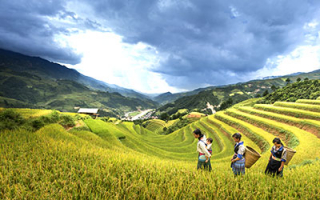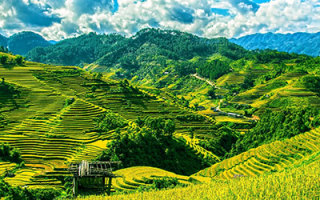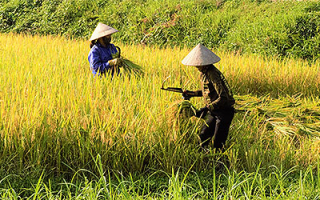Typically found in the hilly areas, the terraced landscapes of Vietnam have permitted pond-field techniques for rice cultivation to be used in mountainous terrain. This agricultural practice has shaped astonishing landscapes, where traditions and living experiences related to rice cultivation live on.
Over recent years the terraced rice fields in Vietnam have become much better known. This is particularly true of Mu Cang Chai, a remote district located in the country’s Northwest mountain range. Becoming an emerging tourist destination can be an opportunity for local socio-economic development, but it also poses a potential threat to the integrity of this complex living structure in rural settings.
Community-based tourism, a successful model largely applied in the Southeast Asian mountainous rice terraces, has been recently integrated in Mu Cang Chai as a sustainable tool to safeguard and valorize the site and the intangible heritage that surrounds it.
Mu Cang Chai rice terraces: cultural wealth found in pristine nature
Situated at the foot of Hoang Lien Son mountain range, the Mu Cang Chai terraced landscape is representative of a living culture’s harmonious interaction with nature. With great ingenuity, the indigenous culture has transformed the mountain’s harsh natural conditions. Despite unpropitious circumstances, local farmers applied scientific knowledge together with spiritual beliefs and rituals to maximize the annual harvest.
Since water and irrigation systems play a vital role in the rice field, the local farmers were required to develop sophisticated water distribution channels to deal with the lack of water resources and the specific topography at high attitude. They used bamboo pipes to draw the water from the mountain, at 1000 meters above sea level, while keeping it from flowing downhill. In parallel, indigenous people practice “calling for wind and rain” rituals to regulate rainfall, the main water resource that supplied the rice fields, aside from the numerous streams coming from the rocky mountain.
The Mu Cang Chai rice paddies are also home to a wide mix of ethnic minority groups such as H’Mong, Dao, Thai, etc. As such, their fascination does not merely reside in the stunning natural scenery itself, but also in the diverse cultural values it embodies. Each minority group has its own beliefs, social practices and farming lifestyle, resulting from a long process of crystallizing and transmitting traditional knowledge over generations.
Making up 95% of the population living around the slopes, the H’mong ethnic group was the first indigenous group that settled in this hilly mountain area. As a result, the history of these rice terraces is strongly connected with H’mong history and living culture, adding a distinctive charm to the site. Visiting Mu Cang Chai today, visitors are amazed by the unique local way of living, which seems far removed from the so-called modern lifestyle. Living in the steeply mountainous area, most of the inhabitants still practice fire-fallow cultivation as their main agricultural activity, apart from growing rice. Besides work in the fields, their everyday life revolves around their houses, keeping animals, making handicrafts, worshipping their ancestors and going to the local market where all local social and economic activities take place.
Nowadays, Mu Cang Chai possesses nearly 500 hectares of rice terraces named as “National Site Heritage” in 2007. The zone encompasses La Pan Tan, Che Cu Nha and Ze Xu Phinh communes. This mesmerizing site has been globally recognized as “one of the most striking green landscapes in the world,” resulting in significant attention from the international traveller communities.
Community-based tourism: review and perspectives
Travellers visit the distant district year round, especially during the rainy season starting in April. This is when the seedling rice fields are watered, giving a shimmering reflection of the greenish mountain. Another peak period falls from September to October when the rice terraces ripen and turn into an infinite golden silk scarf stretching along the district.
The area’s increasing fame has brought a growing number of tourists to one of the country’s most marginalized areas and offered many economic benefits to local communities. These include income boosting, job creation and regenerating of traditional crafts and cultural practices. However, uncurbed tourism could bring negative impacts to the physical structure and intangible values associated with this living heritage. Considering the fragility of such a complex living structure facing multiple problems of sustainability, local stakeholders have started to put into practice a paradigm of community-based tourism, in order to preserve and valorize the cultural landscape better.
In recent years, local communities have been encouraged to get involved in the blossoming tourism industry, in order to make both residents and tourists benefit from the cultural richness of this living heritage. The implementation of community-based tourism aims to provide tourists with a deeper understanding of the landscape, and thus better appreciate the material and immaterial values embedded in the site, through authentic experiences with the local people. Regarding the inhabitants, their taking part in tourism activities helps improve their income and fosters their sense of belonging to their territory. Sharing their indigenous knowledge and practices with the visitor is their badge of pride, and defines the site’s identity.
A great variety of tourism activities are being carried out with a high level of local involvement. Aside from regular trekking and walking tours, the tourist journey in Mu Cang Chai has more flavour thanks to the rice cycle tours that invite tourist to immerse themselves in the local culture. The tour program offers travellers the chance to take part in the daily life of local residents by joining them in fieldwork, participating in handicraft and rice wine production, attending ethnic cultural shows or even learning local musical instruments. An exceptional part of the tour is exploring local cuisine through cooking activities with a host family and sampling regional delicacies. Tasting the amazing Tu Le sticky rice, esteemed for its delicate smell and rich flavour, would definitely step up the visitors’ experience!
In order to improve the professionalism and quality of provided services, the local authorities have organized dedicated training courses for local ethnic minorities, to give them the basic tools to greet visitors, conduct tours, and improve their communication skills.
By offering homestays and selling the wide array of handicrafts and local agricultural products, the paradigm appears to be an opportunity for local communities to improve their lives. Its economic benefits are encouraging a growing number of local families to engage in the industry. In fact, the number of family-run homestays in the district risen from two to 15 in the last two years, demonstrating the potential growth of this service.
Despite all the short-term positive impacts on local lives, developing tourism in a living landscape may generate issues relating to physical deterioration, commodification and commercialization of local culture for tourism purposes, and ruptures in the linkage between rituals and the values they embody. To benefit local communities better, tourism should be developed gradually and combined with educational programmes, making local populations aware of both positive and negative impacts that tourism can have on their territory. Apart from scientific analysis, particular attention should be given to anthropological studies to establish a sustainable tourism plan that meets the local communities’ needs and expectations.
Thi Thanh Tu LE
European Master of Dynamics of Cultural Landscapes and Heritage Management
ICCROM Intern, Collections Unit



